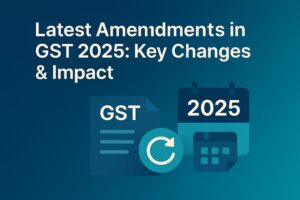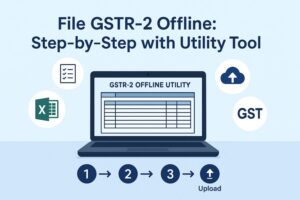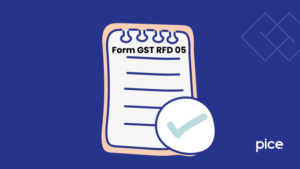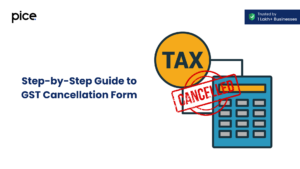Know about Section 40: First Return Under GST
- 17 Jan 25
- 12 mins
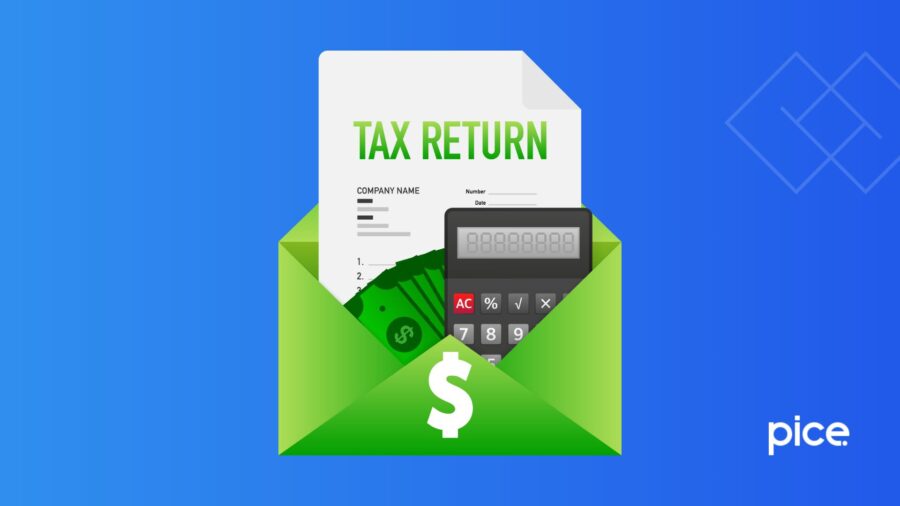
Know about Section 40: First Return Under GST
Key Takeaways
- GST streamlines tax filing with periodic returns, consolidating sales, purchases, and tax liabilities under a single system.
- The tax framework includes CGST, SGST, IGST, and UTGST, each catering to specific transaction types like intrastate, interstate, and Union Territories.
- Businesses must file various GST returns, such as GSTR-1 for sales and GSTR-3B for a tax summary, ensuring accurate reporting and compliance.
- Newly registered businesses must file a first return detailing transactions from the date of liability until registration approval to maintain compliance.
- TDS returns can be filed online using the GST portal, requiring accurate statements, digital signatures, and step-by-step validation for submission.
GST, or Goods and Services Tax, is a comprehensive tax system that has replaced multiple indirect taxes in India. It is designed to streamline the process of tax collection and promote ease of doing business across the country. Under GST, businesses are required to register and file returns periodically, reporting details of their sales, purchases and tax liabilities.
For new GST registrants, one of the first crucial steps is filing the first return under GST. This initial filing includes important details about the business's transactions from the date they became liable for GST registration until the date their registration was officially granted. To learn more about the first return under GST, scroll through this blog.
What Is the GST Return?
A GST return is a record that includes details of all GST invoices, payments and receipts within a specific timeframe. Taxpayers must report all business-related transactions that impact revenue, including their first return under GST. Based on these declarations, authorities determine the business's tax liability.
Business owners can submit their GST returns online through the official portal managed by the Goods and Services Tax Network (GSTN).
💡If you want to streamline your payment and make GST payments, consider using the PICE App. Explore the PICE App today and take your business to new heights.
To file GST returns, registered dealers need to provide the following details for the relevant period:
- Total sales
- Total purchases
- Output GST (GST collected from customers)
- Input Tax Credit (ITC), which is the GST paid on purchases
After filing, the status of the GST return can be checked online, ensuring business compliance with necessary regulations.
It is also crucial to select the appropriate GST form before starting the return filing process. The GST system includes 11 different forms, each serving a specific purpose and having a unique due date. For instance, GSTR-1 must be submitted by the 10th of each month to report outward supplies of taxable goods. With the necessary information and your GST number in hand, choose the correct form and ensure timely filing through the online portal.
Who Should File a GST Return?
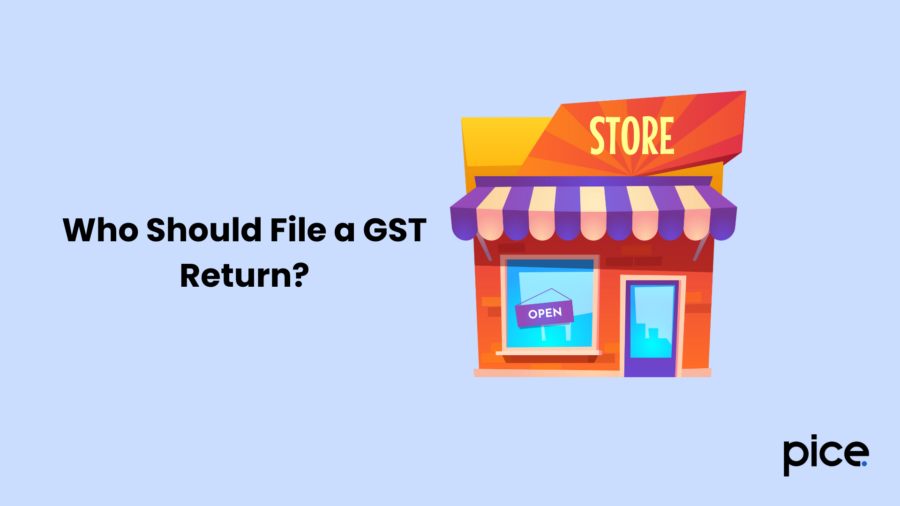
As per the GST Act, individuals or entities involved in supplying goods or services with an annual turnover above the specified threshold are required to file GST returns. This applies to businesses, manufacturers, service providers, traders and e-commerce operators. Additionally, entities registered under the GST composition scheme must also comply with return filing requirements.
Even if there are no transactions during a particular tax period, registered entities are obligated to file a nil return. Failure to comply can result in penalties.
GST returns must be submitted online through the GST portal within the prescribed deadlines. Filing returns on time helps to maintain business compliance and ensure uninterrupted business operations.
The GST network maintains data on registered buyers and sellers. Businesses engaged in the supply of goods or services are required to file three monthly returns along with one annual GST return. This process can be completed using a simple spreadsheet-based template.
Types of GST Returns (GSTR)
Here is a list of different types of returns in India:
GSTR-1
GSTR-1 is used to report details of all outward supplies of goods and services. It includes B2B and B2C invoices and debit-credit notes issued for sales during a specific tax period. This return must be filed by all registered person under GST. Any amendments made to sales invoices, even for previous tax periods, must also be reported in GSTR-1 by all registered suppliers or sellers.
GSTR-2A
GSTR-2A is a dynamic, read-only GST return designed for buyers or recipients of goods and services. It displays details of inward supplies (purchases) made from GST-registered suppliers during a tax period. This information is auto-generated based on the suppliers’ GSTR-1 filings and data submitted via the Invoice Furnishing Facility (IFF) by QRMP taxpayers. Buyers can refer to this return to claim accurate ITC for multiple financial periods. If any invoices are missing, buyers can request suppliers to upload them in their GSTR-1.
GSTR-2B
GSTR-2B is a static, view-only GST return available monthly since August 2020. It provides constant ITC data for a specific period, covering filings from the previous month's GSTR-1 until the current month's GSTR-1 filing date.
Available on the 12th of every month, GSTR-2B helps buyers reconcile ITC details before filing GSTR-3B. It also specifies actions for individual invoices, such as ineligible ITC or reversal requirements, with references to GSTR-3B tables.
GSTR-2
GSTR-2, which is currently suspended, was meant for registered buyers to report inward supplies (purchases). Unlike GSTR-2A, GSTR-2 allowed editing and had to be filed by all regular taxpayers under GST. Its suspension has been in effect since September 2017.
GSTR-3
GSTR-3, now suspended, was a monthly summary return including outward supplies, inward supplies, ITC claimed, tax liabilities and taxes paid. It was auto-generated from GSTR-1 and GSTR-2 filings and was mandatory for all regular taxpayers until its suspension in September 2017.
GSTR-3B
GSTR-3B is a self-declared monthly return summarising details of outward supplies, ITC claimed, tax liabilities and taxes paid. It must be filed by all regular taxpayers. Reconciliation with GSTR-1 and GSTR-2B is essential before filing GSTR-3B to avoid discrepancies that could lead to GST notices or registration suspension.
GSTR-4
GSTR-4 is the annual return by composition taxpayers by April 30th of the subsequent financial year. It replaced GSTR-9A from FY 2019-20.
Before FY 2019-20, the quarterly return filing of GSTR-4 was done, but it was later replaced by the CMP-08 challan system filed every quarter by the 18th of the following month. The composition scheme allows businesses with aggregate turnover up to ₹1.5 crore to pay GST at a fixed rate. Service providers with turnover up to ₹50 lakh can also opt for a similar scheme.
GSTR-5
GSTR-5 is for non-resident taxable person conducting business in India. It includes details of outward supplies, inward supplies, credit or debit notes, tax liabilities and taxes paid. This return is filed monthly by the 20th.
GSTR-5A
GSTR-5A return is a summary return for reporting taxable supplies and tax liabilities by Online Information and Database Access or Retrieval (OIDAR) service providers. It is filed monthly by the 20th.
GSTR-6
GSTR-6 is a monthly return form for Input Service Distributors (ISD) to report ITC received and distributed. It also includes details of issued documents and their distribution method. The due date is the 13th of each month.
GSTR-7
GSTR-7 is filed by those registrants who have collected TDS under the Goods and Service Tax Act. It also describes the TDS amount deducted, the TDS amount payable, payment of tax and refunds. The filing of returns is done before the 10th of every month.
GSTR-8
GSTR-8 is for e-commerce operators who are supposed to collect TCS under the GST regime. It covers supply disbursed through the platform and TCS collected. It must be filed by the 10th of every month.
GSTR-9
GSTR-9 is an annual return filed by GST-registered taxpayers, consolidating details from monthly or quarterly return filing (GSTR-1, GSTR-2A, GSTR-3B). It includes outward and inward supplies, tax liabilities and HSN code summaries. The due date is December 31st of the following financial year. GSTR-9A was previously an annual return for composition taxpayers. It was replaced by GSTR-4 (annual return) from FY 2019-20 onwards.
GSTR-9C
GSTR-9C is a reconciliation statement for taxpayers with aggregate turnover exceeding ₹5 crore in a financial year. It compares GSTR-9 data with the taxpayer’s books of accounts. It must be filed by December 31st, aligning with the GSTR-9 deadline.
GSTR-10
GSTR-10, also known as the final return, is filed by taxpayers whose GST registration has been cancelled or surrendered. It is due within three months of the cancellation date or order.
GSTR-11
GSTR-11 is for individuals with a Unique Identity Number (UIN), such as foreign diplomatic missions, to claim GST refunds on inward supplies. It includes supply details and refund claims.
What Is the First Return in GST?
The first return under GST is an initial declaration that a newly registered taxpayer files. It includes details of all outward supplies made during the period starting from the date the individual or entity became liable for GST registration up to the date their registration was officially approved. This return is submitted after the grant of registration process is completed.
What Information to Include in GSTR-1?
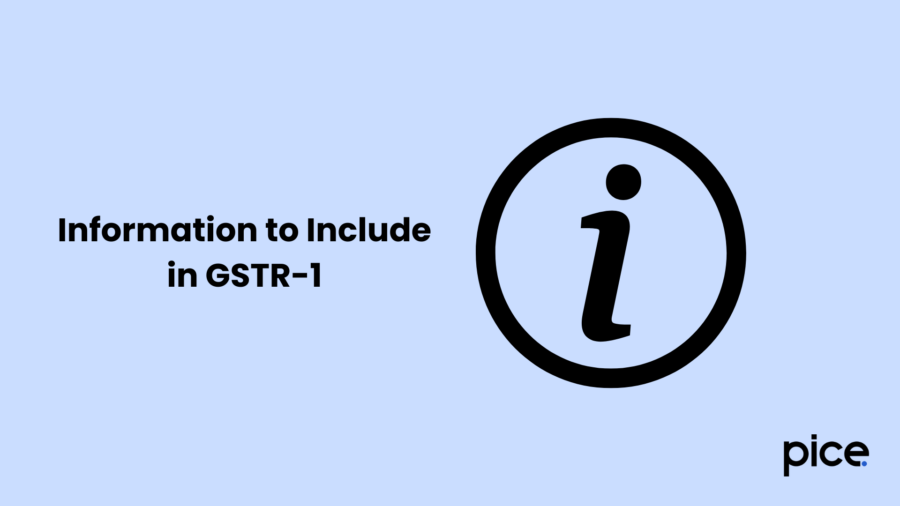
GSTR-1 should include information on all sales and services provided by the taxpayer throughout the return filing period. When filing GSTR-1, businesses must provide the following details:
| Table No. | Details or Information to be Submitted |
| 1, 2 & 3 | GSTIN, trade name, legal name and total turnover in the previous financial year |
| 4 | Taxable supplies to registered taxpayers, excluding zero-rated supplies and deemed exports |
| 5 | Inter-state taxable supplies to unregistered persons where the invoice value exceeds ₹2.5 lakh |
| 6 | Zero-rated supplies and supplies that are considered deemed exports |
| 7 | Taxable transactions made to individuals or entities that are not registered, excluding those transactions listed in Table 5 (after accounting for debit and credit notes) |
| 8 | Supplies that are nil-rated, exempt or outside the scope of GST |
| 9 | Amendments to taxable supplies (reported in earlier GSTR-1 returns) during the current period. This includes adjustments for credit notes, debit notes and refund vouchers issued in the period under review. |
| 10 | Provide details of any credit notes or debit notes issued to unregistered persons during the period |
| 11 | Advances received for supplies in the current tax period, including any adjustments made in the period for advances |
| 12 | Provide a summary of outward supplies categorised by HSN codes |
| 13 | Issuance of documents during the period |
| 14 | For suppliers selling through e-commerce operators (ECOs), report GSTIN-wise sales on which the e-commerce operators are liable to collect Tax Collected at Source (TCS) under Section 52 of the CGST Act, or where ECOs are required to pay tax under Section 9(5) of the CGST Act. |
| 14A | Amendments to sales data reported under Table 14 |
| 15 | E-commerce operators need to report both B2B and B2C sales of suppliers on which they must deposit TCS. |
| 15A | Amendments to e-commerce operator report in relation to B2B and B2C sales:Table 15A I: Amendments related to sales to GST-registered persons (B2B).Table 15A II: Amendments related to sales to unregistered persons (B2C). |
How to File TDS Return in GST Portal?
Business owners can file TDS returns online via the GST portal. The return filing procedure is mentioned below:
- Go to the official GST portal.
- Tap on the ‘Login Here’ option.
- Provide your user ID or TAN, password and captcha code.
- Select the ‘Login’ option.
- Find the TDS tab and choose ‘Upload TDS’.
- The taxpayer must choose the appropriate statement details, such as form name, financial year, upload type and quarter, from the provided form.
- Select 'Validate' to check the details in the statement.
- Use a Digital Signature Certificate (DSC) to upload the TDS statement.
- Upload the ZIP archive containing the TDS statement and attach the signature file.
- Press 'Upload' to complete the return filing process.
Conclusion
Filing the first return under GST is an essential step for businesses newly registered under the GST regime. This first return sets the foundation for ensuring direct tax compliance with GST regulations and avoids penalties.
 By
By 






